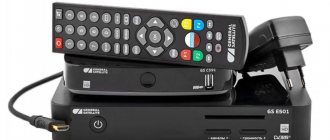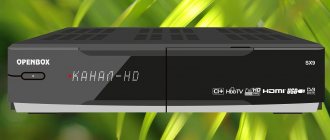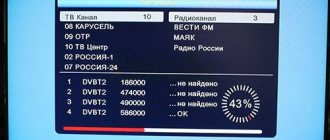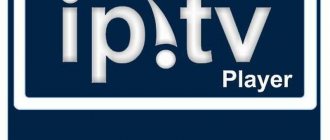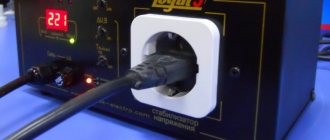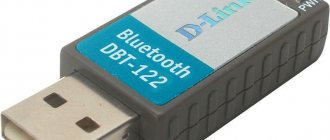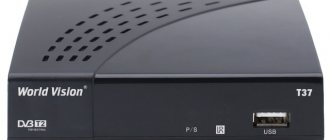The name HD (High-Definition) is familiar to almost every person. Today, the definition of “high resolution” applies to everything that is in any way related to the broadcast of video material - smartphones, cameras, displays and even smart glasses. But most often we hear this concept together with television broadcasting - HDTV.
Modern transmission of television signals is carried out using digital coding, and in order for the picture to be displayed on the screen, a special converter is needed - a receiver for the TV. What kind of equipment is this? What are the broadcasting standards? And how to choose the best device? Let's try to figure it out.
What is a digital receiver
Digital television is a method of receiving a television signal in digital format. New technologies allow broadcasters to broadcast the highest quality sound, images with improved clarity and a wider range of channels than was previously possible.
Before the advent of DTV (Digital television), analog signals were transmitted in a similar way to radio: in fact, the television video signal was transmitted in the AM band, and sound was transmitted on FM frequencies. As a result, analogue television transmissions were subject to interference, the image became snowy and distorted, depending on the geographic distance of the device receiving the signal.
Additionally, the amount of bandwidth assigned to an analog television channel limited the resolution and overall picture quality. The analogue television transmission standard was called NTSC (National Television System Committee). Its basis is 525 lines, 60 fields, 30 frames per second and a frequency of 60 Hz for video transmission. This is interlaced scanning, in which each picture is presented in two fields of 262 stripes, and then all the lines are combined into a single image.
These days, a common perception of digital television is that it is broadcast from signal towers that receive signals from satellites and transmit them to home receivers. The standard for such transmission is designated DVB-S2 or DVB-S. This is the magic of satellite transmission and it is reliable as long as the satellite is in sight.
However, this is not the only way to transmit television signals. Another popular method of transmitting digital video broadcasting signals is terrestrial, which is referred to as DVB-T. In this method, digital signals do not leave the Earth, but they are not transmitted via cable, but from antenna to antenna, from the signal provider to the home receiver. But the DVB-C standard is just cable digital television.
Digital television can be divided into three types according to the method of signal transmission:
- DVB-S2, DVB-S – satellite TV;
- DVB-C – cable TV;
- DVB-T2 – terrestrial TV.
Depending on the type of signal, the appropriate equipment is purchased: for DVB-S2, DVB-S - a satellite receiver, for receiving DVB-C - a cable digital receiver, and for DVB-T2 - terrestrial receivers. >
DVB broadcasters transmit data using a compressed digital audio/video stream. The new digital format can transmit several channels in one frequency band occupied by one analogue television channel, which makes it possible to more economically use the scarce radio spectrum. In addition, DVB provides many new features that analogue television could not offer.
Digital television is transmitted in a binary number system in the form of bits, just as data is created on a computer: music, video or audio content. A digital signal is built on two values: “1” and “0,” which determine whether the signal is “on” or “off.” The user always sees a clear image or his screen simply does not show anything, but there can be no interference, distortion or loss of color.
Since a DTV signal is made up of "bits", the same amount of bandwidth that a current analog TV signal occupies can accommodate not only a higher quality picture in digital form, but also additional space that can accommodate additional video, audio, and text signals.
The signal comes in digital, so it is important that the TV receiver can decipher and read it. If the TV operates in an analog system, then it will need an additional DTV converter - a digital receiver for the TV.
What is the job of a digital TV receiver and what is it for? To perform four main tasks:
- Receive and amplify digital television signals;
- Decode it and convert it to an analog signal for output via RCA or SCART connectors, or convert it to a digital signal for output via the HDMI port;
- Play multimedia content from USB drives;
- Perform the functions of recording, pausing and deferring television viewing.
Receivers are also often called set-top boxes, receivers, tuners, digital media renderers or digital television decoders. Such devices run on software, so their conditional access module can be easily reflashed, that is, the internal program can be changed. This means that this equipment never becomes obsolete, since its software content can be updated at any time.
The only characteristic that can make such a device irrelevant is the supported formats. If you have an old model of receiver that can only work with MPEG-2, then you will not be able to watch video in MPEG-4 format, and for this you will have to buy a new decoder model.
It is interesting to note that the transition from analogue to digital television is only one step. Although all HDTVs are digital televisions, not every digital television broadcast is HD, and not all digital televisions are capable of displaying high-definition images.
Choosing a company
Today, the most popular and best-selling receivers are those provided by the following companies:
- Openbox
- Dreambox
- Orton
- Strong
- Tiger
Over the years, these manufacturers have proven themselves to be excellent in terms of the quality of the products they offer.
It is best to purchase a receiver from official dealers and distributors, or order from the official websites of the manufacturers themselves, since there is a high probability that subscribers may come across counterfeits in other places.
If a subscriber purchases a fake, it is possible that the receiver will not operate correctly and software updates will not be possible. Therefore, if the subscriber has chosen a specific receiver, then on the manufacturer’s official website it will be necessary to read reviews and recommendations on how to protect yourself from purchasing a counterfeit and where to find official partner stores.
What are the broadcasting standards?
The A/V receiver is the center of your home theater. This is the electronic component that controls digital television. It connects:
- To the antenna (terrestrial receiver);
- To a satellite cable (satellite receiver);
- To a cable television network (cable receiver);
- To interactive TV (IPTV receiver).
Digital Terrestrial TV is a popular form of television for people migrating from analogue to digital services. Relatively hassle-free digital terrestrial TV is received through your existing TV antenna, providing minimal disruption to your TV viewing and little extra cost.
Digital satellite television, as the name suggests, refers to television that is received via a satellite dish, so to receive this format, you must have a satellite dish installed on the front of your home. There are no geographical restrictions on this service, since the digital television signal is transmitted directly from satellites in orbit. This technique is common in places where there are difficulties with broadcasting.
Digital cable television is delivered by the provider in a limited coverage area, through a network of high-speed fiber optic cables. To receive a signal via cable, the subscriber needs the receiver itself, an antenna, a converter and an AC power supply.
The most popular today are digital receivers for TVs of the DVB-T2 standard. They are the best at transmitting the broadcast signal because they do so directly, without additional devices for intermediate transmission or decoding of the signal.
Now, as for the formats:
- PAL, NTSC and SECAM are the most common analog formats that transmit images with a resolution of no more than 720 × 480 pixels;
- HDTV is a new digital broadcasting format, which means that the television picture will be high definition with a resolution of 1,280 by 720 or 1,920 by 1,080 pixels.
HDTV requires less bandwidth due to digital video compression. In addition, HDTV screens are about a third wider than tube TV displays, which is more consistent with the range of peripheral vision of the human eye, so they are more comfortable for viewing:
- The HD-Ready format has a resolution of 720p;
- Full-HD is 1080p.
Some receivers now have the ability to decode Dolby TrueHD and DTS Master Audio, which are found on some Blu-ray discs.
Receiver GS-8306B/S - latest model 2021
Today, the latest receiver for watching television provided by the Tricolor provider in Full HD is the GS-8306B/S brand receiver. It supports DVB-S and DVB-S2 (HD) broadcast standards. The receiver has an attractive, fashionable design and all the necessary functions for accessing Tricolor satellite television channels.
But speaking about the additional functions of the receiver, GS-8306B/S, nothing special can be noted. If subscribers are not demanding of the receiver and just want to “turn it on and watch,” then a branded receiver of this type is ideal, without unnecessary overpayments.
How to choose a receiver for TV
To choose the right digital receiver model, you should pay attention to the following characteristics:
- Broadcast Standards;
- Supported formats;
- Connectors and interfaces;
- Antenna selection;
- Multiplex packages.
We have already discussed the standards, formats and antennas of television broadcasting above. When buying a decoder, you just need to know which TV standard comes into your apartment and through which cable it is supplied. The image format is selected depending on the capabilities of your television receiver. Any HD signal will be accepted, but it will be downscaled to the resolution your TV can handle.
Connectors are a very important compatibility parameter. The most common interfaces that can be found in receivers:
- RCA – video and audio signal in stereo format;
- HDMI – high definition digital multimedia;
- USB (different versions 2:0; 3:0) – serial interface for connecting peripheral devices;
- AHT – antenna input/output;
- Card Reader – for reading memory cards;
- Connector for connecting a power supply.
Selecting the remote control
The receiver's remote control should be hand-friendly and multi-functional.
What must be in the remote control?
- Buttons for switching channels and convenient navigation through the list;
- Button to access connected USB storage devices;
- Button for displaying information about the channel being watched;
- Button to open the signal level information window;
- Buttons to control video recording and playback.
Antenna selection and multiplex packages
An antenna for digital television must be decimeter, that is, be able to receive decimeter (UHF) waves. Such radio waves are in the range from 1 m to 10 cm, which corresponds to a frequency of 300 MHz to 3 GHz UHF.
Digital television multiplex is a set of channels or a television package. That is, not one channel is broadcast on one frequency, but several at once. One transmitter and a whole package of television broadcasts.
On the territory of the Russian Federation today you can watch two digital television multiplexes, each of which broadcasts ten channels:
- Package “RTRS-1” – Channel One, Russia-1, Russia-2 Match-TV, NTV, Channel Five, Russia “Culture”, Russia 24, Karusel, OTR, TVC.
- Package "RTRS-2" - REN-TV, SPAS, STS, Domashny, TV-3, Friday, Zvezda, Mir, TNT, Muz-TV.
Which channels will be included in these packages are decided differently every year, based on an open competition. The possibility of launching a third multiplex is being considered, but this is only in plans for now. The state is also working to expand the television coverage area of these packages as quickly as possible, so that any resident of even the most remote areas has the opportunity to install a receiver and receive digital television in their apartment.
Access card module support
As already stated above, in order to access and decode the channels of the Tricolor provider, you will need to obtain special access. This is what makes the provider’s branded receivers good, since the required access is initially implemented in their receivers.
As for neutral receivers, to access the satellite television operator Tricolor TV you need a special module into which a smart access card is inserted, it opens access to the provider and decodes TV channel packages.
Example: a subscriber has a Strong receiver and wants to watch TV channels from the Tricolor provider on it. To do this, you will need to obtain the DRE CRYPT CAM MPEG4 module and a smart card. The resulting module will need to be inserted into the appropriate slot of the receiver, after which a smart card must be inserted into the module.
In addition to CAM modules, the receivers have card readers into which the access card is inserted directly; in this case, operation of the receiver and viewing of Tricolor TV channels will be possible without CAM modules.
It is necessary to clarify the possibility of using a Tricolor card on a specific receiver, but, as a rule, this option is available in almost all receivers.
When choosing a receiver, it is better if it has support for several CAM modules and smart cards so that subscribers can simultaneously have access to several satellite TV providers.
⇡#Chicken or the egg?
Well, it's time to take stock. Unlike other ecosystem builders who focus on smart speakers, Sber preferred a different format - set-top boxes. And it seems to me that this is a good choice: if we can catch Sber’s target audience anywhere, it’s at the TV. But SberBox is several products in one, and everything that does not concern basic functions does not yet make a serious impression. A separate article can be written about the features of the interface and the instability of its operation. SberZvuk is currently only suitable for playing background music on the command “turn on jazz,” and everything related to online shopping is a demonstration of the capabilities of the technology, but not a real user product. .
Right now, the SberBox set-top box is available in many retail chains and online stores at a price of 2,990 rubles. And the Okko Smart Box, which is very similar to it, costs 2,490 - the price difference is not that big. But in the same price category there are many other TV set-top boxes, including Google Chromecast and Xiaomi Mi TV Stick, which do not limit the user in customizing the shell and choosing online cinemas and other services.
Perhaps, over time, most of the shortcomings of SberBox will be corrected. Maybe you can even put Netflix on it! And without a doubt, the emergence of such devices is necessary in order to develop innovative services. But while these innovative services operate only in demo mode, few enthusiasts will decide to support the development of innovations with rubles. Chicken and egg problem.
What is it for?
First of all, the set-top box works for broadcasting digital television. Transmitting a signal from a satellite to a receiver is the main task of a tuner. In addition, the device has other functions:
- displaying video via flash drives and other USB media;
- recording any video on the appropriate device;
- pause a show, movie, etc.
An Android Smart set-top box has much greater capabilities. This device provides not only television viewing, but also Internet access. Thanks to this, the user receives the following capabilities:
- watching any video or film from the Internet;
- play online games;
- communicating with friends on social networks or through relevant programs.
Availability of “Picture in Picture” mode
The mode in the receiver allows you to view two channels simultaneously. For example, if a subscriber is watching one channel, then by turning on “picture in picture”, another window will open for him, in which you can see what is being broadcast on other channels. The presence of this mode is not a mandatory feature, but it is very convenient.
Possible faults
Most often, the consoles work without interruption. Even if the connection was made by a person without experience or special skills, there should be no problems with the work. If you cannot establish a connection, there may be several reasons:
- The console is malfunctioning. If the device does not work, it is recommended to take it to a service center, however, in some cases it is more advisable to purchase a new device.
- Damage to any cable. You can try changing the wires and finding the channels again. If the search is successful, then the problem has been resolved.
- Problems with the operation of operator equipment. In this case, an icon indicating an IP address error will appear on the screen. To resolve the problem, it is recommended to contact your provider's technical support.
A set-top box for watching digital TV is a device that provides high-quality reception from a satellite and its transmission to a TV. Thanks to this, users have access to watch their favorite channels in high quality. Even a beginner will have no problems setting up the equipment.
Do you need a blind search function?
The presence of this function in the receiver allows you to scan new transponders on the satellite that have not been entered into the receiver’s memory.
A transponder is a kind of “cell” that contains several channels. Therefore, if a new transponder is opened on the satellite, but this transponder is not entered into the receiver’s memory by the program, then the receiver will not see the channels located on it.
Blind Search scans the satellite system for new transponders, and the channels on them will become available.
Advantages of the device
The attachment has the following advantages:
- provides high quality images;
- Digital TV set-top box allows you to watch 20 channels for free;
- is compatible with multichannel TV, when one event can be viewed from several angles;
- ensures uninterrupted broadcasting of all channels thanks to a stable signal;
- allows you to customize the sound;
- has additional capabilities - includes subtitles and shows the TV program of any channel whose signal it receives.
